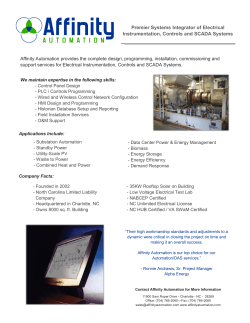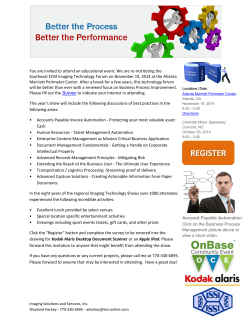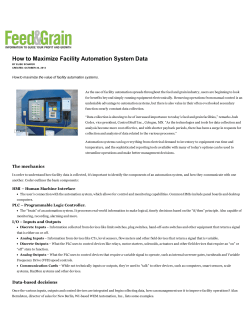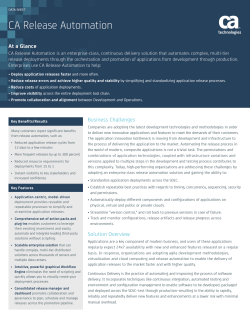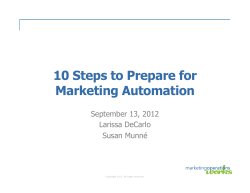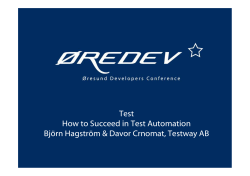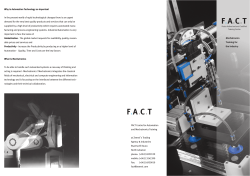
New System Integration - Optimal Industrial Automation Ltd
New System Integration A new type of System Integration offering... In this issue: 50% productivity increase for a Pharma manufacturer Developing a high speed vision system for blister packs Solving legacy control problems by reverse engineering Leading edge vision inspection systems Celebrating 27 years as a leader in process technology Put PAT into practice now RETROFIT & UPGRADING PROCESS SOFTWARE & EQUIPMENT News on the latest Pharmaceutical automation projects designed, developed, manufactured and implemented, with full software development and integration. Whether you are extending an existing production line, upgrading process equipment or building an entirely new plant, this is the essential read to ensure that your upgrade delivers on production, efficiency and reporting targets. 2 | www.optimal-ltd.co.uk “We automate and improve the performance and productivity of all types of FBD: large and small, fully automatic and semi automatic, new build and refurbished, solvent and non solvent based,” said Martin Gadsby, a Director of Optimal. “Using a range of automation vendor hardware and software, the systems we have supplied range from those with very traditional push button controls, through systems with HMI interfaces, to those with full-blown Client Server SCADA and even DCS.” www.optimal-ltd.co.uk | 3 Optimal legacy control system upgrade of fluidised bed dryer delivers 50% increase in productivity for pharma manufacturer Optimal Automation has highlighted its ability to automate and improve the productivity of fluidised bed dryers, following the upgrade of a legacy control system to a PLC and networked SCADA system on a large FBD, for a major blue chip pharmaceutical client. By closely working with the client, in relation to optimising the efficiency of plant operation, Optimal have been able to deliver a staggering 50% increase in productivity for the FBD. The replacement of a legacy control system, in the most recent of Optimal’s FBD projects, involved a control strategy that encompassed not only tower automation, but also all the batching of raw materials, including dispensary control, together with tracking of raw materials and finished product in IBCs. The system supplied by Optimal to achieve these objectives has a Siemens PLC plus a client server WinCC SCADA system at its heart, the SCADA having four clients plus an engineering station. A sophisticated recipe system was integrated into the SCADA, and client specific Batch Reports are generated, these being used as part of the total batch release documentation set. The investment by the pharmaceutical manufacturer in the Optimal solution has been paid back swiftly, via the 50% increase in productivity that has been achieved. In another recent project, a leading manufacturer of pharmaceuticals installed Optimal’s synTQ® PAT (Process Analytical Technology) Data Management system on a fluidised bed drier. The initial objective of the installation was to determine if positive gains could be made, in terms of the consistency of quality and in terms of reducing processing time, by using real time moisture monitoring and control to reduce the cycle time and determine in real time the process end point. In this project, synTQ® was used in combination with a 3rd party multivariate analysis (MVA) product and a NIR instrument. The project was not however just simple end point determination – by building Orchestrations (PAT Methods), Process Models, and gaining process understanding, the client was able to determine - in real time - the drying phases that were occurring in the drier. He was then able, by means of the Orchestrations within synTQ®, together with a 3rd party control system and the OPC connection from synTQ®, to design an application that controlled the drying temperature in line with the stage of the process, as determined by synTQ®, and introduce real time dryer end point control. The system has proved to be very successful, and has, once again, delivered a short payback time, maximising ROI. This was a relatively simple 1st PAT project for the client, however having started with a simple project that proved the worth of PAT, the client has gained PAT deployment experience and skills, and they have proved to themselves that the technology works and can deliver very real benefits. They now intend to optimise other aspects of their processes by using PAT. 4 | www.optimal-ltd.co.uk Optimal develops high speed vision system that inspects two sealed blister packs per second, with zero tolerance Optimal Industrial Automation has overcome immense challenges to produce a high speed vision system for a major pharmaceutical manufacturer that inspects for seven key visual parameters relating to sealed blister packs at two per second. The packs are for the Japanese market, have Japanese text, and must have both sides 100% inspected. The challenge is compounded, due to the natural (but acceptable) variation in the blister packs, and the fact that they are made from aluminium foil, which is highly reflective. Optimal undertook the high speed inspection project after the pharmaceutical manufacturer had investigated buying a system from a standard supplier, but none was available. The company was approached because of its track record of executing complex vision inspection projects. “The client’s requirements were daunting,” said Martin Gadsby, a Director of Optimal. “He needed to inspect to a standard that was higher than anywhere else: in effect, a zero tolerance standard. In addition, the speed of the line and the very small visual differences between the required standard and those that had to be rejected, were major issues that had not been addressed before in the industry. These factors, together with the aforementioned problem of a highly reflective product, made the project very challenging indeed, and were presumably why other vision inspection companies had declined to take it on.” The importance of the overprint was of paramount: it is in Japanese characters and the system has to inspect it as such. Without an effective inspection system to perform this function, the production process would have been at best www.optimal-ltd.co.uk | 5 The specification for the vision inspection system called for seven quality factors to be inspected. These were: Correct lot code and expiry date; correct overprint with no defects; and verification that there were: 1. No scratches, 2. No dents, 3. No marks 4. No holes and 5. No surface contamination of any kind on the blister pack. inefficient; at worst, the company would not have been able to export the product to Japan. The task of providing a vision system to meet the customer’s requirements involved Optimal in - first of all - developing a detailed understanding of the production process and the product itself, and then producing a technology leap in both hardware and software to achieve success. As with most vision inspection systems the lighting was critical. Optimal undertook a significant research and development programme where it developed a range of lighting techniques that had to be used in a specific sequence in order to provide the desired effects, whilst not being affected to too great an extent by the natural variations that occur in the blister packs. In addition to lighting techniques, Optimal also developed specialised software technology that would enable the required image analysis to occur in a real time, and produce the desired responses despite the natural and acceptable variation in the blister packs. In combination with the lighting techniques and its regulatory compliant operator interface software for machine vision - synTI®, the specialist software is able to produce excellent and robust results that is also easy for the operators to use. Therefore, after much development, Optimal has produced a system that integrates high speed digital cameras, lighting, image analysis techniques and a software package that identifies sub-standard packs correctly, so as to trigger their rejection from the production line. “The fact that the blister packs reflect light made the acquisition of useful images very difficult, and also increased the difficulty of being able to see the desired surface defects to the required resolution,” said Martin Gadsby. “Also, the blister pockets naturally move in each blister: not a huge amount, but sufficient to make a simple direct image comparison invalid. To overcome these problems, multiple images using differing lighting techniques were found to be necessary, all of these having to be correctly synchronised to each blister pack. Having developed the system we then tested it extensively. Unfortunately, accurate detection of the blisters still proved to be a problem, because if they are not detected entering the system at exactly the correct time, then the timing of the process is thrown out. We trialled several sensing techniques before settling on one that addressed this problem. Then, once the lighting was optimised and the timing of the products passing through the system was made robust, the image analysis was optimised by developing the image analysis algorithms in the high level software. The final system was then tested against product directly coming from the production line, to ensure that all of the naturally occurring variations had been catered for. Once this was achieved, the system was formally validated and passed for production purposes. It is now in daily operation and we are looking to build upon its success by talking to other customers that are interested in the technology.” 6 | www.optimal-ltd.co.uk Optimal industrial automation solves problem of legacy control, with re-engineering of DCS, PLC, SCADA and MES systems control system upgrade is left until the failure occurs, then there will be a high pressure situation for all involved to get the new system in and running again as quickly as possible. As a result, production improvements will be low on the priority list and will not be implemented.” With the ending of the first generation of factory automation, there are an increasing number of control systems that are becoming obsolete, presenting a major problem of replacement to the system user. These ‘legacy’ control systems, as they are known, are difficult to maintain and support. Spare parts are a problem, and finding skilled personnel to provide system support, both hardware and software, becomes increasingly difficult. What all this means for the system user is that the control system that has been running his process reliably for the past several years is increasingly operating upon borrowed time. Moreover, to compound matters, when the system does fail, it will probably be at the worst possible time for production; and getting it to run again will be difficult, and almost certainly time consuming, because, very often, documentation and even the software for legacy systems is lacking. Now, by working closely with users of legacy systems, Optimal Industrial Automation is able to provide a solution to these problems. By using skills and experience built up over 27-years, Optimal is able to reverse engineer most processes, allowing the replacement of any control system – irrespective of type or make – with a modern equivalent that is well documented and fully supported. “There are a number of very good reasons for replacing, or implementing the upgrade of a legacy control system before it fails,” said Martin Gadsby, a Director of Optimal. “The first of these is Timing. The change over to a new system can be timed to suit production demands, and so the impact on production is minimised. The second is Cost. An upgrade executed under an emergency situation will cost more, not only in the short term, but also the long term as any payback potential will have been lost. Third, and final, is Functionality Improvements. If the After the upgrade the system will, therefore, continue to run as it did previously, and any potential improvements that could have given a meaningful payback will have been lost. The process of upgrading a legacy control system involves Optimal in surveying the system, understanding its functionality and then preparing a detailed functional design specification for a replacement system. Optimal is uniquely qualified to perform these functions, as it has its own complete in-house electrical design and build capability, where full systems can be designed and manufactured. This is complemented by software services that cover the full spectrum, from PLCs through SCADA to DCS, plus high level languages such as C# & VB DotNet, and database work, including real time industrial databases. In addition, Optimal also has the skills to configure and programme machine vision systems, servo systems and robots. www.optimal-ltd.co.uk | 7 Optimal celebrates 27 years of process automation Optimal Automation, a world leader in data management and PAT implementation, plus - one of the UK’s premier designers, builders, programmers and installers of PLC, SCADA, DCS, MES and vision systems, celebrates its 27th anniversary in 2014. Optimal is one of the leading developers and integrators of process analytical technology (PAT) solutions for the Life Sciences and Chemical sectors using its own in-house developed synTQ data management software. The software is used independently all around the world and is also part of a Global Marketing Alliance with Emerson Process Management. Optimal is also a market leader in vision systems - manufacturing its own 21 CFR Part 11 compliant packages. As a generalist automation system integrator the company is also very well respected, as is evidenced by its appointment as a Tier 1 Solutions Provider for Siemens, an Approved Systems Integrator for ABB, and a Software Solutions Provider for Rockwell Automation. In addition, Optimal has for some years been an approved Siemens WinCC Professional and PCS7 Integrator. This comprises a very select number of companies that have been audited, examined, and through displaying extensive experience, have been approved as high level integrators for the Simatic WinCC and PCS7 product ranges including FDA 21 CFR Part II compliant projects in the pharmaceutical industry. Martin Gadsby. “We work with the majority of the top tier global Life Sciences companies on automation and PAT projects, and have designed and implemented automation projects for Automotive, Food and Drink, Chemical, Power Generation and Aerospace companies that improve quality, throughput and time to market.” International commissioning and support Optimal is a truly international organisation, handling projects globally. “Since we design and build special purpose machines in addition to developing and implementing automation hardware Optimal Industrial Automation Limited Goodrich Close, Westerleigh Business Park, Yate, Bristol, BS37 5YT, United Kingdom T: +44 (0) 1454 333 222 F: +44 (0) 1454 322 240 E: sales@optimal-ltd.co.uk W: www.optimal-ltd.co.uk 8 and software solutions for SMEs as well as Global multinationals, our commissioning teams will travel virtually anywhere in the world to install equipment and software solutions.” Optimal’s modern purpose built factory is strategically located on the Westerleigh Business Park, at Yate near Bristol. The factory enables Optimal to provide a complete inhouse design and build capability covering all aspects of automation. These include: •Huge & diverse software capability •Electrical & electronic design + build •Special purpose machinery design + assembly •Complete unit operational test + development •Full documentation + validation services •International installation + commissioning •Training + technical support Industrial Automation
© Copyright 2025
